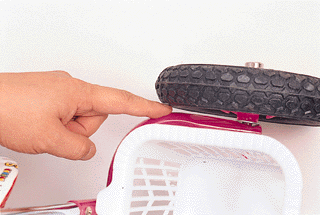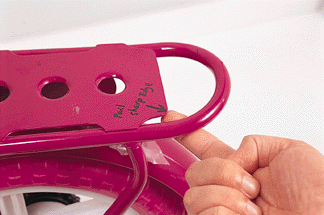Small tricycles or bicycles are welcome gifts for young children. They are usually the first real vehicles owned – and propelled - by children.
In selecting a tricycle or bicycle for a child, safety consideration must be of a paramount importance.
The Consumer Council today reported on the investigation into the safety of children's bicycles and tricycles by the Customs and Excise Department, which resulted in the prosecution and conviction of 4 importers and wholesalers for supplying substandard children's bicycles and tricycles for sales.
The offenders were fined between $10,000 and $80,000 under the Toys and Children's Products Safety Ordinance.
In addition, a total of 90 children's tricycles (79) and bicycles (11) valued about$21,000 were ordered by the court to be destroyed.
The Department has also issued written warning to 12 retailers prohibiting the sales of non-complying children's bicycles and tricycles in future.
A total of 26 models of children's bicycles (8) and tricycles (18) were put to test in accordance with the requirements of the Ordinance. Highlights of major non-compliances, published in the latest (250th) issue of the Council's monthly magazine 'CHOICE', include:
- spaces of width greater than 5 mm but smaller than 12 mm between the wheel and the body of the vehicle, posing an entrapment hazard (21 samples or 81%);
 |
 |
- burrs on the edges, posing a laceration hazard (2 samples or 8%);

- slots of width greater than 5 mm on the front wheel (where the peddles of the tricycle are positioned), posing an entrapment hazard to the toes (7 samples or 39%);
- incomplete chain and crank shields on bicycles, posing an entrapment hazard (5 samples or 63%);

- brake failure on bicycles (6 samples or 75%);
- excessive chromium and lead on the paint coating (5 samples or 19%); and
- insufficient marking and instructions (22 samples or 85%).
Consumers are urged to consult the test findings and safety guidelines in the selection of a children's bicycle or tricycle in this issue of 'CHOICE'.
If you have any doubt about the safety of the bicycle or tricycle your children are playing with, you are well advised to put a stop to it immediately.
Statistics of injuries caused by children's bicycles or tricycles are not available in Hong Kong. But it was reported in April this year, an infant girl aged 1 had her right finger caught in the chain and chain wheels of a children's bicycle. Firemen had to be called to extricate the child's finger from the bike.
Meanwhile, since the enforcement of the Toys and Children's Products Safety Ordinance on July 1993, the Customs and Excise Department (CED) has received a total of 147complaints - toys (63) and children's products (76).
It is welcoming to note that the number of complaints received and the number and value of seizures by the CED are on a gradual decrease. For example, the value of seizure falls from the peak of $4.47 million in 1994 to about $35,000 in the first half of this year.
Colour dyes can work wonders with garments. They turn our clothes so much more fashionable and interesting.
But some colour dyes do have some potential hazard since harmful substances could be released under certain conditions.
To examine the problem, the Consumer Council has conducted a test to detect the presence of harmful colour dyes in garments.
Included in the test were a total of 44 T-shirt samples purchased from different retail outlets throughout the territory. T-shirts were chosen because of the diversity of colours of this popular daily wear.
The test, conducted by the Government Laboratory, has detected (after a special "reduction" process) excessive concentrations of harmful substances in the azo dyes of 4 of the samples.
All but the 4 in question were otherwise given a clean bill of health.
The substances detected were among a list of 20 harmful chemicals released from some azo dyes. Germany has banned the use of azo dyes which could release such harmful substances, in consumer goods.
The 4 T-shirt samples in question were found to release, after special treatment, a suspected carcinogen, dianisidine (3,3'-Dimethoxybenzidine). Two of them were found to also release benzidine, a confirmed carcinogen.
In both cases, the concentrations of carcinogens released were in excess of the safety standard of 30 mg per kilogram set by German authorities.
And, despite 3 washings, the harmful substances were still detected in the dyes of these garments.
All 4 samples found with harmful substances, after special treatment, were purchased from street hawkers. They represent only a relatively small percentage of the samples (24) sourced from such outlets.
These T-shirts were lowly-priced imitation products of designer brands. As none bears label of country of origin, it could not be traced if these garments were locally manufactured or imported from abroad.
Samples bought from department stores and fashion chain stores had no similar problem. All were found to be in compliance with the German standard.
According to the test report, published in this August issue of 'CHOICE', it is not possible to distinguish banned azo dyes in a coloured product with the naked eye.
But the health hazard posed by harmful azo dyes appears to remain a controversy. So far, only Germany, Netherlands and India have taken action to prohibit the use of harmful azo dyes. Hong Kong, like the US and other European countries, has no such prohibition. However, it is understood that the European Commission is reviewing the matter.
A study of the US Consumer Product Safety Commission in 1983 found that there is no risk to the wearer from textiles coloured with azo dyes as they do not penetrate the skin.
But a recent Netherlands study has concluded that the risks to public health associated with the presence of harmful azo dyes in clothing and related articles are not negligible.
In spite of this controversy, the Consumer Council deems that any unnecessary exposure to harmful substances is undesirable especially if the potential hazard could be prevented since there are substitute dyes available.
The hazard of exposure is probably greater to workers employed in dyeing plants using azo dyes. Both the Government and the industries concerned are aware of the problem and the appropriate controls and a advisory service have been put in place.
The use of benzidine and dianisidine is regulated in Hong Kong: the former is banned under the Factory and Industrial Undertakings (Carcinogenic Substances) Regulations while the latter is subject to strict control and all workers involved have to be protected and undertake regular medical examinations.
The Government is of the view that since there is no definitive international consensus that azo dyes or products made from such dyes are carcinogenic, there is no need at this stage to regulate the use or import of the azo dyes.
However, the Consumer Council has been assured that most local garment manufacturers and related industries have long ceased using the azo dyes restricted in Germany and the Netherlands.
Local importers, wholesalers and retailers of consumer goods , on the other hand, are urged to impose a condition that the goods supplied to them are free from the prohibited azo dyes.
Don't be an ostrich and bury your head in the sand. Ask questions to be informed.
That's sound advice if you are seriously contemplating about investing your hard-earned money on what are known as ostrich trading or farming schemes.
The attention of the Consumer Council has recently been drawn to the promotion of a number of ostrich schemes. According to some advertisements, high returns (of as high as40% per annum) could be achieved from ostrich investment.
Investors need only to purchase a few pair of ostriches which are kept and reared by the farms somewhere outside of Hong Kong. Profits would then be gained when the progeny of the ostriches are sold.
These ostrich schemes were presumably conceived on the basis that there is fast growing worldwide demand for ostriches resulting in high prices for ostrich end products.
The Securities and Futures Commission has reviewed the documentation of a number of ostrich schemes and is of the opinion that, prima facie, they are not within the scope of the Protection of Investors Ordinance. However, investors should be wary of the potential risks posed by these schemes.
A UK journal, the Investors Chronicle, has reported earlier this year the closure of operation of an ostrich investment scheme.
The operator, it was reported, persuaded an estimated 2,700 people to pay up to £17,000 a bird by "guaranteeing" returns of over 50% a year.
After the closure, it was found that over a third of the 4,000 ostriches sold to investors appeared to have died or never existed. And the real value of ostriches was thought to be nearer £ 1,500 a bird.
Consumers or potential investors are advised to consult the report on such ostrich schemes in this August issue of 'CHOICE'.
Other highlights in this 250th issue of 'CHOICE' include:
- Forecast completion of private domestic property in 1997 and1998 - completion of private domestic housing is expected to number 58,000 units whereas completion of subsidized domestic properties to number 35,000 units . For this year, completion of private domestic properties is expected to number 21,950 units with high concentration in the New Territories especially in Yuen Long and Tsuen Wan.
- Comparison of affordability ratio between 1995 and 1997 - the affordability ratio recorded at 58% in the first quarter of 1996, the lowest during the period 1995-1997. The affordability ratio during the first quarter of 1997 was about 75%, which is 17% up from the first quarter of 1996, thus weakening the ability of an average family to afford the mortgage payment for a say 430 sq.ft. flat.
- Diabetes and Sweeteners - according to a study during 1995-96, 1 in 11 adults in Hong Kong suffers from Diabetes Mellitus (DM). The prevalence of those above 65 years old is 10 times as high as those between 25 and 35 years old. An essential part of the therapy is to adopt an appropriate meal plan to maintain appropriate blood sugar level, and absorb enough energy to maintain reasonable body weight. No single meal plan can meet all the needs of diabetes. Doctors or dieticians should be consulted for individualized meal plans to meet their therapeutic goals. On the other hand, the daily use of table sugar cause no harm to health if not ingested in excess. Artificial sweeteners, though has an image of meeting the needs of diabetes and those on diet, are not all non-caloric (O calories), neither do they have the same quality as sugar. Besides limiting the use of sweeteners, using various sweeteners instead of a single sweetener is a prudent way to prevent exceeding the Acceptable Daily Intake.



